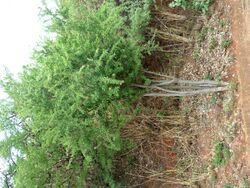Biology:Gymnosporia buxifolia
| Pioneer spike-thorn | |
|---|---|

| |
| Scientific classification | |
| Kingdom: | Plantae |
| Clade: | Tracheophytes |
| Clade: | Angiosperms |
| Clade: | Eudicots |
| Clade: | Rosids |
| Order: | Celastrales |
| Family: | Celastraceae |
| Genus: | Gymnosporia |
| Species: | G. buxifolia
|
| Binomial name | |
| Gymnosporia buxifolia (L.) Szyszyl. (1888)
| |
| Synonyms[1] | |
| |
Gymnosporia buxifolia is a species of plant in the bittersweet family (Celastraceae) native to southern Africa.[2] It is commonly known as the pioneer spike-thorn or common spike-thorn.[3] It ranges from Angola and Mozambique to South Africa .[1]
Description
Gymnosporia buxifolia is a variable evergreen shrub or tree.[4]
Morphology
Gymnosporia buxifolia grows up to 9 metres tall. It has light brown bark that darkens with age, eventually becoming flakey, rough, corky and fissured. It may be unarmed or armed with long straight spines.[5] up to six inches (15 centimeters) in length;[6] the longest unbranched thorns of any Dicot, a record shared with Vachellia karroo. It needs to be added that certain cacti have spines (not thorns) which are longer. The leaves are green, slightly paler on underside, glabrous, often borne clustered on very short dwarf spur-branchlets in the axils of the spines or infrequently on young spines or arranged spirally on new growth. The leaves are variable in shape, but typically narrowly obovate to oblanceolate, 25mm to 45mm long and 10mm to 25mm wide with a toothed margin, usually on the upper half of the leaf, sometimes emarginate. Flowers are borne in heads, small, white with strong odour. The fruit is a more or less spherical, 3 lobed capsule, about 10mm diameter, green-yellow becoming grey-brown and wrinkled when dry.[7] It grows in forests, scrub, grassland, woodland and riverine habitats.[4]
Gallery
Conservation
It is listed as Least Concern in the Redlist of South African Plants.[3]
References
- ↑ 1.0 1.1 Gymnosporia buxifolia (L.) Szyszył. Plants of the World Online. Retrieved 7 October 2023.
- ↑ "Plants of Southern Africa". SANBI. http://newposa.sanbi.org/sanbi/Explore.
- ↑ 3.0 3.1 "Redlist of South African Plants". SANBI. http://redlist.sanbi.org/species.php?species=1883-5. Retrieved 25 April 2018.
- ↑ 4.0 4.1 "Gymnosporia buxifolia (L.) Szyszyl.". Conservatoire et Jardin botaniques Ville de Genève. 2012. http://www.ville-ge.ch/musinfo/bd/cjb/africa/details.php?langue=an&id=78693. Retrieved 25 April 2018.
- ↑ "JStore Global Plants". https://plants.jstor.org/compilation/gymnosporia.buxifolia?searchUri=qtype%3Dall%26query%3DGymnosporia%2Bbuxifolia. Retrieved 25 April 2018.
- ↑ William A. Cannon, General and Physiological Features of the More Arid Portions of Southern Africa....etc.(August 1924) Carnegie Publication Number 354 Plate 7c with caption
- ↑ Coates Palgrave, Keith; Coates Palgrave, Meg (2005). Trees of Southern Africa (3, imp. 3 ed.). Cape Town: Struik Publishers. p. 604.
Wikidata ☰ Q13035756 entry
 |





